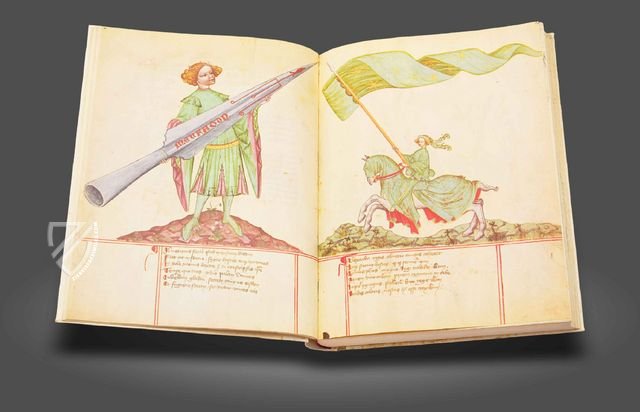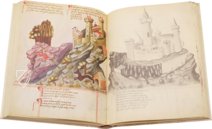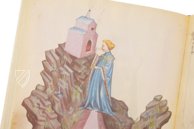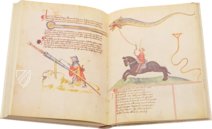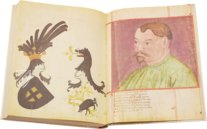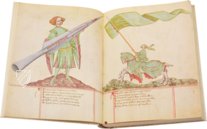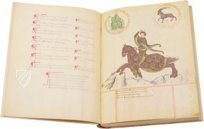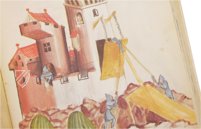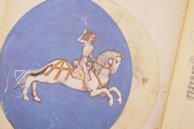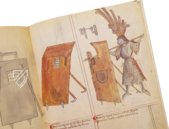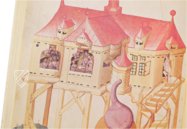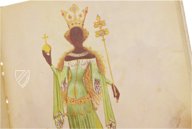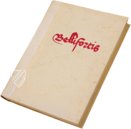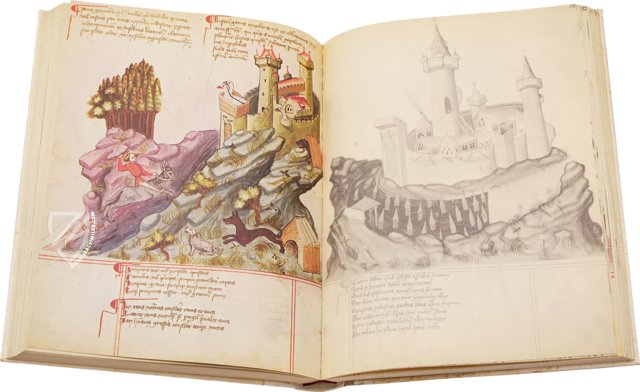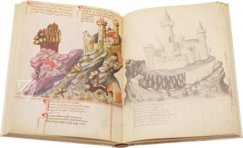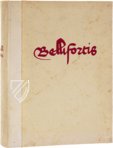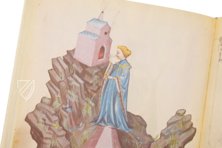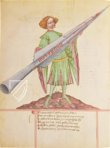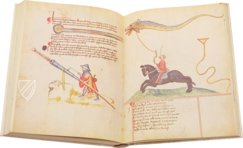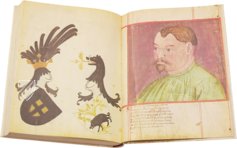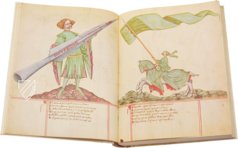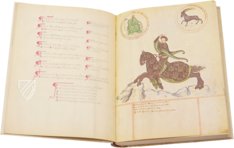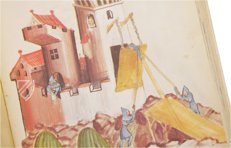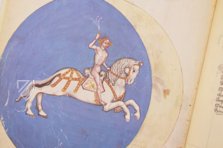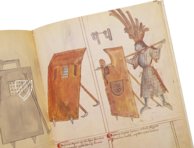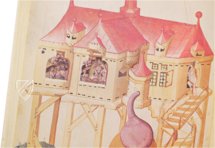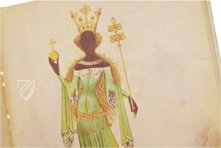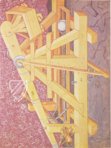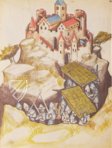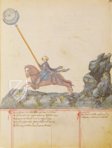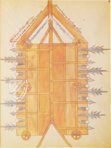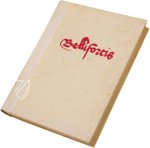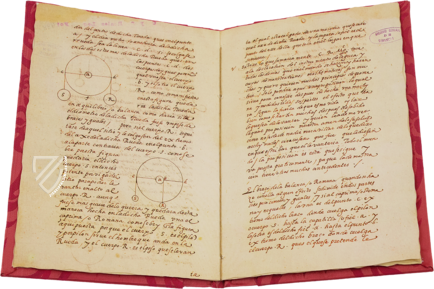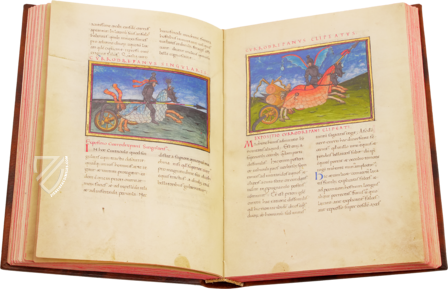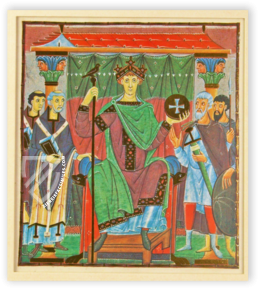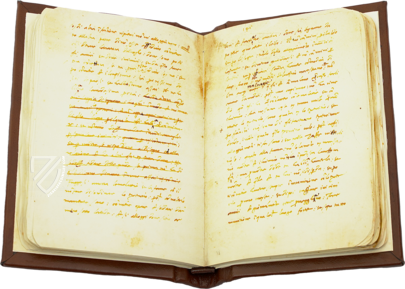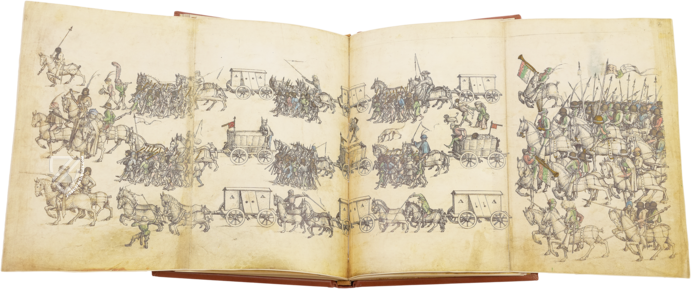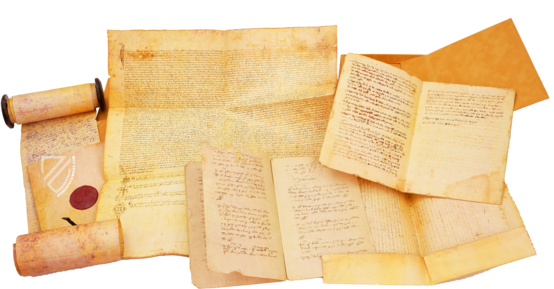Bellifortis
(under 1,000€)
The most important military treatise of the Late Middle Ages presented in the sophisticated style of the Gothic period: the Bellifortis by Konrad Kyeser (1366 – after 1405). Its contents are a collection of ancient Roman military treatises and the latest designs for weapons of war. Furthermore, the work takes into account the effects of astrology and magic on warfare, making it a truly comprehensive work on the art of war. His work is adorned by illustrations that are exemplary specimens of the Gothic style and even include a realistic portrait of the author, the first of its kind since Late Antiquity.
Bellifortis
Konrad Kyeser (1366 – after 1405) was the author of the most important illustrated treatise on military engineering from the Late Middle Ages, which is evident from the fact that at least twelve 15th century copies of the manuscript and ca. 45 altogether survive today. Bellifortis can be translated as "Strong in War" or "War Fortifications" and is concerned with the art of siege warfare in particular. The German military engineer and physician began work on the original manuscript in Prague for King Wenceslaus IV of Bohemia (1361-1419), but after Wenceslaus was deposed in 1400, Kyeser went into exile in his hometown of Eichstätt, during which time he finished the work and dedicated it to the new King Rupert of Germany (1352-1410). The work summarizes material from classical authors like Vegetius and Frontinus while also depicting “cutting edge” military technology but is also heavily impregnated with allusions to astrology and magic.
A Masterpiece Created in Exile
The artwork of the original manuscript indicates that the illuminators were themselves exiles from the royal court of King Wenceslaus in Prague, one of the richest and most sophisticated in Europe and arguably the birthplace of the International Gothic style. As a result, this important treatise on the art of war is illustrated in a manner that is second to none and dedicated to no less than a king. A portrait of Kyeser found in the text is arguably the first realistic depiction of an author since Late Antiquity. The backbone of the work consists of two classical texts: De re militari, a Roman military manual written by Publius Flavius Vegetius Renatus in the late-4th century, and Strategemata, a collection of examples of military stratagems from ancient Greek and Roman history written by Sextus Julius Frontinus (ca. AD 40-103), who served the Emperor Domitian as a general in Germania.
Magic and Warfare
Kyeser believed that warfare was best studied by considering every possible factor, including astrology and sorcery. Thus, magic is presented in the Bellifortis alongside depictions of weapons both old and new: trebuchets, battering rams, movable portable bridges, cannons, rockets, chariots, ships, mills, scaling ladders, incendiary devices, crossbows, and instruments of torture are all depicted in great detail by eminent masters of Gothic art. Alexander the Great in particular is presented as an example of a great general who makes use of various war tactics while also being a military inventor. The famous Macedonian is shown both holding rocket-like weapons in his hands while being credited with the creation of large war carriages and is even portrayed with magical abilities. Nonetheless, Kyeser does not dispense with realistic considerations and expressed his belief that the armies of the Holy Roman Empire would benefit from the enterprising and inventive nature of the German people: "Just as the sky shines with stars, Germany shines forth with liberal disciplines, is embellished with mechanics, and adorned with diverse arts."
Codicology
- Alternative Titles
- Conrad Kyeser aus Eichstätt: Bellifortis
- Size / Format
- 280 pages / 34.0 × 25.0 cm
- Origin
- Germany
- Date
- 1402–1405
- Epochs
- Style
- Language
- Script
- Littera bastarda
- Illustrations
- Many expansive miniatures, some of them full-page
- Content
- Manual of military technology, based on De Re Militari by Vegetius and Strategemata by Frontinus
- Patron
- Wenceslaus IV of Bohemia, King of Germany
Rupert of the Palatinate, King of Germany - Artist / School
- Konrad Kyeser (author)
Bellifortis
Archimedean Screw
This miniature of an Archimedean screw is the oldest surviving representation of this device in the Middle Ages. However, the hydraulic machine, also known as a screw pump, is not a medieval invention, but was already known in antiquity - possibly as early as 8th or 7th century BC Mesopotamia. Both in antiquity and in the Middle Ages, Archimedean screws were primarily used to transfer water to a higher level. Here's how it works: Inside a pipe, a precisely fitted screw rotates around the central axis. This repeatedly creates closed compartments in which the water is spiraled upward.
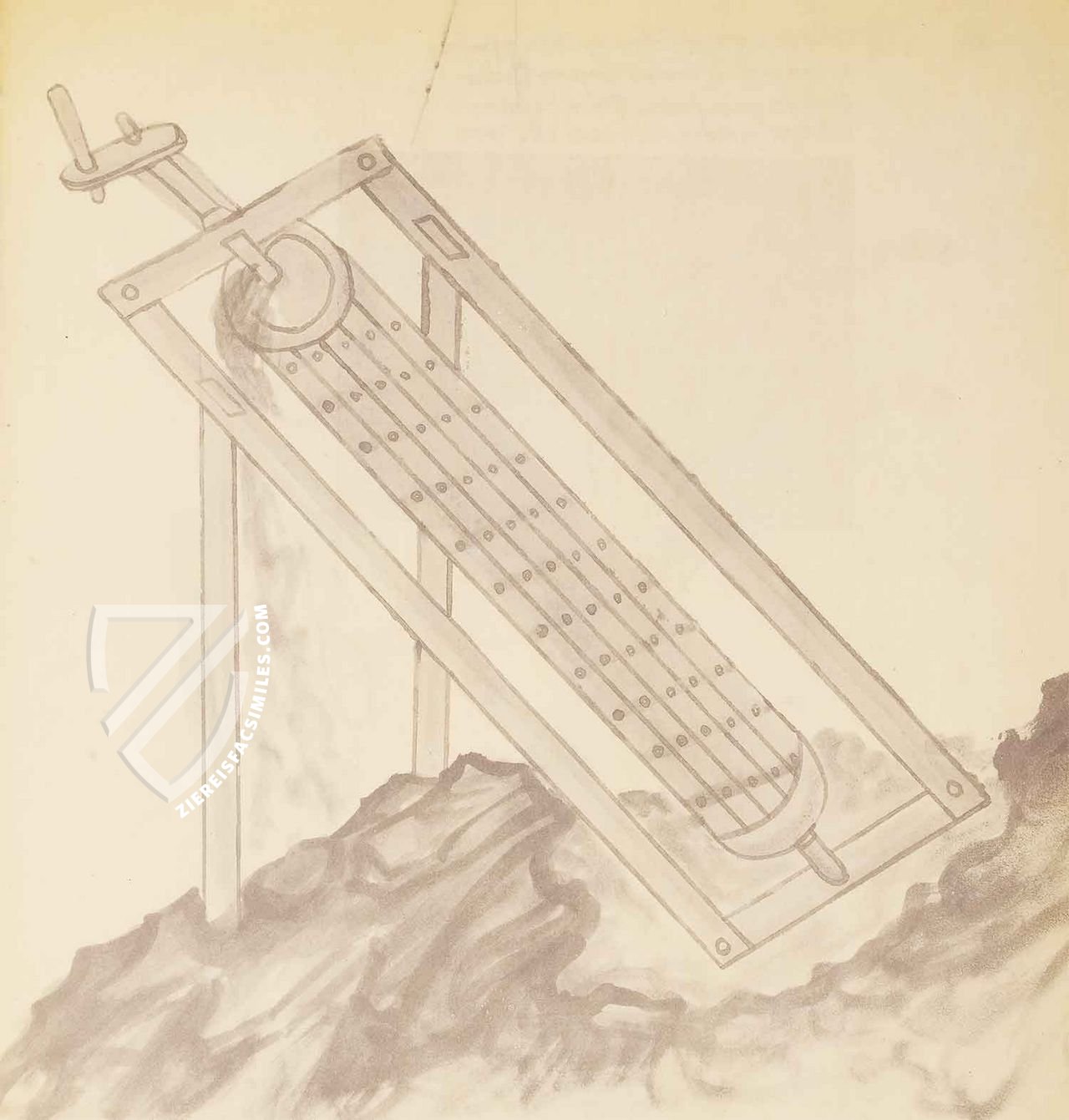
Bellifortis
Spearhead 'Meufaton'
In 334 BC Alexander the Great began his Conquest of the Achaemenid Persian Empire, which was only the starting point of his imperial intentions. Legend says that after crossing the Hellespont (today's Dardanelles) with his enormous army, he threw his spear 'Almerio' into the soil of the still foreign dominion, symbolizing his supposed claims to the whole of Asia Minor.
The oversized and symbolically charged head of this victory-bringing spear is presented to us in this miniature by a lanky squire with soft facial features and blond curls. Its name, 'Meufaton', is painted on the spearhead along with a mystical sign. The latter is said to enhance the magical effect and, according to the text, should also be painted on the palm of the wearer's hand. The miraculous power of the weapon, which helps the wearer to defeat his enemies, is further represented here by its sheer size.
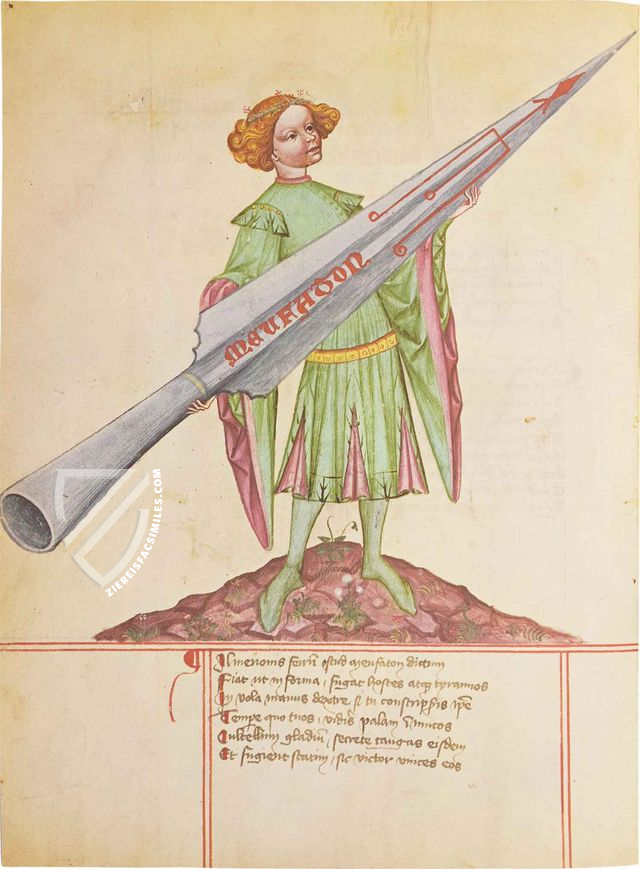
#1 Bellifortis
Language: German
(under 1,000€)
- Treatises / Secular Books
- Apocalypses / Beatus
- Astronomy / Astrology
- Bestiaries
- Bibles / Gospels
- Chronicles / History / Law
- Geography / Maps
- Saints' Lives
- Islam / Oriental
- Judaism / Hebrew
- Single Leaf Collections
- Leonardo da Vinci
- Literature / Poetry
- Liturgical Manuscripts
- Medicine / Botany / Alchemy
- Music
- Mythology / Prophecies
- Psalters
- Other Religious Books
- Games / Hunting
- Private Devotion Books
- Other Genres
- Afghanistan
- Armenia
- Austria
- Belgium
- Belize
- Bosnia and Herzegovina
- China
- Colombia
- Costa Rica
- Croatia
- Cyprus
- Czech Republic
- Denmark
- Egypt
- El Salvador
- Ethiopia
- France
- Germany
- Greece
- Guatemala
- Honduras
- Hungary
- India
- Iran
- Iraq
- Israel
- Italy
- Japan
- Jordan
- Kazakhstan
- Kyrgyzstan
- Lebanon
- Liechtenstein
- Luxembourg
- Mexico
- Morocco
- Netherlands
- Palestine
- Panama
- Peru
- Poland
- Portugal
- Romania
- Russia
- Serbia
- Spain
- Sri Lanka
- Sweden
- Switzerland
- Syria
- Tajikistan
- Turkey
- Turkmenistan
- Ukraine
- United Kingdom
- United States
- Uzbekistan
- Vatican City
- A. Oosthoek, van Holkema & Warendorf
- Aboca Museum
- Ajuntament de Valencia
- Akademie Verlag
- Akademische Druck- u. Verlagsanstalt (ADEVA)
- Aldo Ausilio Editore - Bottega d’Erasmo
- Alecto Historical Editions
- Alkuin Verlag
- Almqvist & Wiksell
- Amilcare Pizzi
- Andreas & Andreas Verlagsbuchhandlung
- Archa 90
- Archiv Verlag
- Archivi Edizioni
- Arnold Verlag
- ARS
- Ars Magna
- ArtCodex
- AyN Ediciones
- Azimuth Editions
- Badenia Verlag
- Bärenreiter-Verlag
- Belser Verlag
- Belser Verlag / WK Wertkontor
- Benziger Verlag
- Bernardinum Wydawnictwo
- BiblioGemma
- Biblioteca Apostolica Vaticana (Vaticanstadt, Vaticanstadt)
- Bibliotheca Palatina Faksimile Verlag
- Bibliotheca Rara
- Boydell & Brewer
- Bramante Edizioni
- Bredius Genootschap
- Brepols Publishers
- British Library
- C. Weckesser
- Caixa Catalunya
- Canesi
- CAPSA, Ars Scriptoria
- Caratzas Brothers, Publishers
- Carus Verlag
- Casamassima Libri
- Centrum Cartographie Verlag GmbH
- Chavane Verlag
- Christian Brandstätter Verlag
- Circulo Cientifico
- Club Bibliófilo Versol
- Club du Livre
- CM Editores
- Collegium Graphicum
- Collezione Apocrifa Da Vinci
- Comissão Nacional para as Comemorações dos Descobrimentos Portugueses
- Coron Verlag
- Corvina
- CTHS
- D. S. Brewer
- Damon
- De Agostini/UTET
- De Nederlandsche Boekhandel
- De Schutter
- Deuschle & Stemmle
- Deutscher Verlag für Kunstwissenschaft
- DIAMM
- Droz
- E. Schreiber Graphische Kunstanstalten
- Ediciones Boreal
- Ediciones Grial
- Ediclube
- Edições Inapa
- Edilan
- Editalia
- Edition Deuschle
- Edition Georg Popp
- Edition Leipzig
- Edition Libri Illustri
- Editiones Reales Sitios S. L.
- Éditions de l'Oiseau Lyre
- Editions Medicina Rara
- Editorial Casariego
- Editorial Mintzoa
- Editrice Antenore
- Editrice Velar
- Edizioni Edison
- Egeria, S.L.
- Eikon Editores
- Electa
- Emery Walker Limited
- Enciclopèdia Catalana
- Eos-Verlag
- Ephesus Publishing
- Ernst Battenberg
- Eugrammia Press
- Extraordinary Editions
- Fackelverlag
- Facsimila Art & Edition
- Facsimile Editions Ltd.
- Facsimilia Art & Edition Ebert KG
- Faksimile Verlag
- Feuermann Verlag
- Folger Shakespeare Library
- Franco Cosimo Panini Editore
- Friedrich Wittig Verlag
- Fundación Hullera Vasco-Leonesa
- G. Braziller
- Gabriele Mazzotta Editore
- Gebr. Mann Verlag
- Gesellschaft für graphische Industrie
- Getty Research Institute
- Giovanni Domenico de Rossi
- Giunti Editore
- Graffiti
- Grafica European Center of Fine Arts
- Guido Pressler
- Guillermo Blazquez
- Gustav Kiepenheuer
- H. N. Abrams
- Harrassowitz
- Harvard University Press
- Helikon
- Hendrickson Publishers
- Henning Oppermann
- Herder Verlag
- Hes & De Graaf Publishers
- Hoepli
- Holbein-Verlag
- Houghton Library
- Hugo Schmidt Verlag
- Idion Verlag
- Il Bulino, edizioni d'arte
- ILte
- Imago
- Insel Verlag
- Insel-Verlag Anton Kippenberger
- Instituto de Estudios Altoaragoneses
- Instituto Nacional de Antropología e Historia
- Introligatornia Budnik Jerzy
- Istituto dell'Enciclopedia Italiana - Treccani
- Istituto Ellenico di Studi Bizantini e Postbizantini
- Istituto Geografico De Agostini
- Istituto Poligrafico e Zecca dello Stato
- Italarte Art Establishments
- Jan Thorbecke Verlag
- Johnson Reprint Corporation
- Josef Stocker
- Josef Stocker-Schmid
- Jugoslavija
- Karl W. Hiersemann
- Kasper Straube
- Kaydeda Ediciones
- Kindler Verlag / Coron Verlag
- Kodansha International Ltd.
- Konrad Kölbl Verlag
- Kurt Wolff Verlag
- La Liberia dello Stato
- La Linea Editrice
- La Meta Editore
- Lambert Schneider
- Landeskreditbank Baden-Württemberg
- Leo S. Olschki
- Les Incunables
- Liber Artis
- Library of Congress
- Libreria Musicale Italiana
- Lichtdruck
- Lito Immagine Editore
- Lumen Artis
- Lund Humphries
- M. Moleiro Editor
- Maison des Sciences de l'homme et de la société de Poitiers
- Manuscriptum
- Martinus Nijhoff
- Maruzen-Yushodo Co. Ltd.
- MASA
- Massada Publishers
- McGraw-Hill
- Metropolitan Museum of Art
- Militos
- Millennium Liber
- Müller & Schindler
- Nahar - Stavit
- Nahar and Steimatzky
- National Library of Wales
- Neri Pozza
- Nova Charta
- Oceanum Verlag
- Odeon
- Orbis Mediaevalis
- Orbis Pictus
- Österreichische Staatsdruckerei
- Oxford University Press
- Pageant Books
- Parzellers Buchverlag
- Patrimonio Ediciones
- Pattloch Verlag
- PIAF
- Pieper Verlag
- Plon-Nourrit et cie
- Poligrafiche Bolis
- Presses Universitaires de Strasbourg
- Prestel Verlag
- Princeton University Press
- Prisma Verlag
- Priuli & Verlucca, editori
- Pro Sport Verlag
- Propyläen Verlag
- Pytheas Books
- Quaternio Verlag Luzern
- Reales Sitios
- Recht-Verlag
- Reichert Verlag
- Reichsdruckerei
- Reprint Verlag
- Riehn & Reusch
- Roberto Vattori Editore
- Rosenkilde and Bagger
- Roxburghe Club
- Salerno Editrice
- Saltellus Press
- Sandoz
- Sarajevo Svjetlost
- Schöck ArtPrint Kft.
- Schulsinger Brothers
- Scolar Press
- Scrinium
- Scripta Maneant
- Scriptorium
- Shazar
- Siloé, arte y bibliofilia
- SISMEL - Edizioni del Galluzzo
- Sociedad Mexicana de Antropología
- Société des Bibliophiles & Iconophiles de Belgique
- Soncin Publishing
- Sorli Ediciones
- Stainer and Bell
- Studer
- Styria Verlag
- Sumptibus Pragopress
- Szegedi Tudomànyegyetem
- Taberna Libraria
- Tarshish Books
- Taschen
- Tempus Libri
- Testimonio Compañía Editorial
- Thames and Hudson
- The Clear Vue Publishing Partnership Limited
- The Facsimile Codex
- The Folio Society
- The Marquess of Normanby
- The Richard III and Yorkist History Trust
- Tip.Le.Co
- TouchArt
- TREC Publishing House
- TRI Publishing Co.
- Trident Editore
- Tuliba Collection
- Typis Regiae Officinae Polygraphicae
- Union Verlag Berlin
- Universidad de Granada
- University of California Press
- University of Chicago Press
- Urs Graf
- Vallecchi
- Van Wijnen
- VCH, Acta Humaniora
- VDI Verlag
- VEB Deutscher Verlag für Musik
- Verlag Anton Pustet / Andreas Verlag
- Verlag Bibliophile Drucke Josef Stocker
- Verlag der Münchner Drucke
- Verlag für Regionalgeschichte
- Verlag Styria
- Vicent Garcia Editores
- W. Turnowski Ltd.
- W. Turnowsky
- Waanders Printers
- Wiener Mechitharisten-Congregation (Wien, Österreich)
- Wissenschaftliche Buchgesellschaft
- Wissenschaftliche Verlagsgesellschaft
- Wydawnictwo Dolnoslaskie
- Xuntanza Editorial
- Zakład Narodowy
- Zollikofer AG

